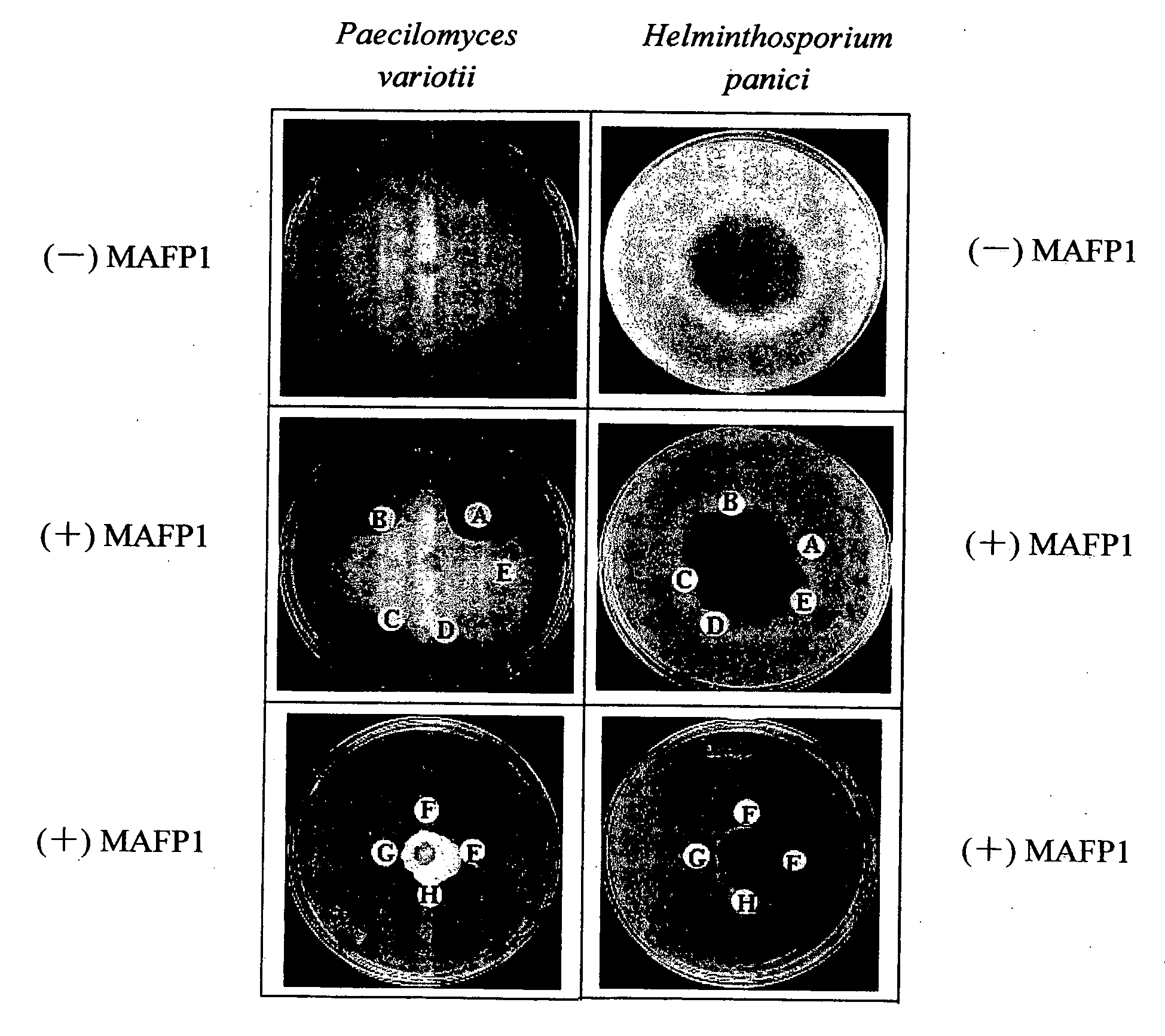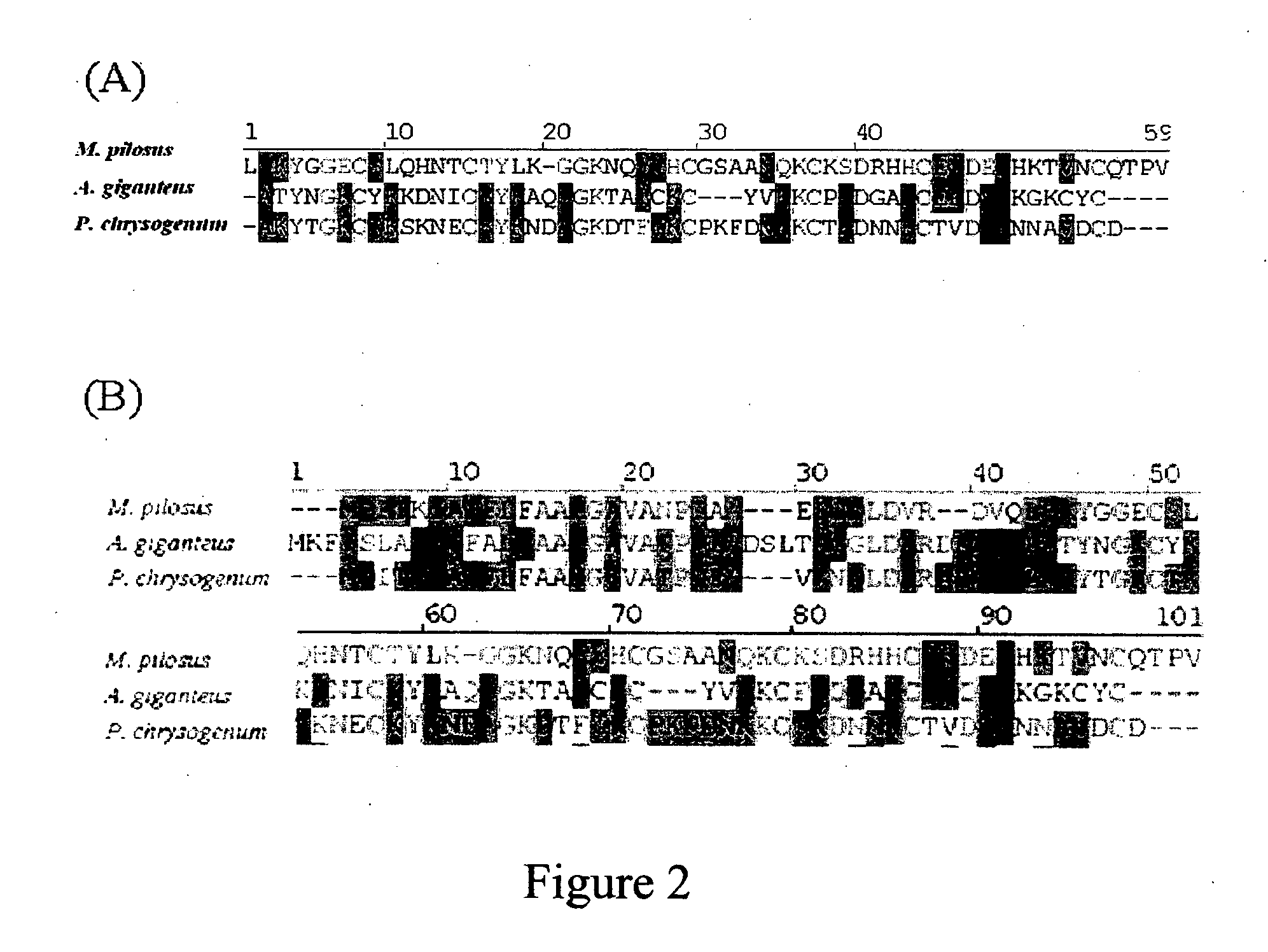Antifungal protein and usage thereof
a technology of antifungal protein and antifungal peptide, which is applied in the direction of peptides, plant/algae/fungi/lichens, drug compositions, etc., can solve the problems of increasing the drug resistance of fungal strains, bad prognosis, and about 40% failure rate of standard treatment for infections
- Summary
- Abstract
- Description
- Claims
- Application Information
AI Technical Summary
Benefits of technology
Problems solved by technology
Method used
Image
Examples
example 1
The Distribution of the mafp1 Gene in Monascus Species
[0092]To discover if the mafp1 gene (SEQ ID NO: 1) exists in various Monascus species, primers for amplifying the mafp1 gene were designed using primer design software (Vector NTI (InforMax) Primer Design). The primers can be paired into 3 groups (1) primer H160-5F (SEQ ID NO: 6) and primer H160-3R (SEQ ID NO: 7), which can be used to amplify full-length sequence of the mafp1 gene; (2) primer H160-5S (SEQ ID NO: 8) and primer H160-3R, which can be used to amplify the nucleotide sequence encoding the sequence comprising the propeptide and the mature MAFP1 region; and (3) primer H160-5P (SEQ ID NO: 9) and primer H160-3R, which can be used to amplify the nucleotide sequence encoding the sequence comprising the mature MAFP1 region.
[0093]Monascus strains were cultured in YM media (7% glycerol, 3% of glucose, 3% of MSG (monosodium L-glutamate), 1.2% of polypetone, 0.2% of NaNO3 and 0.1% MgSO4-7H20, pH6.0) at 25° C. for 9 days. Fungus b...
example 2
Sequence Comparison of the mafp1 Gene of cDNA Thereof in Various Monascus Species
[0096]Cloning and Sequencing of the mafp1 Gene
[0097]Monascus strains were cultured in YM media (7% glycerol, 3% of glucose, 3% of MSG (monosodium L-glutamate), 1.2% of polypetone, 0.2% of NaNO3 and 0.1% MgSO4-7H2O, pH6.0) at 25° C. for 9 days. Fungus bodies and culture fluid were separated by vacuum filtration through 3M filter membrane. The Chromosomal DNA of the fungus was obtained by conventional phenol extraction method using suitable amount of fungus bodies. PCR amplifications were conducted using primers of H160-5F and H160-3R. 100 ng of chromosomal DNA obtained from Monascus strain were used as PCR template. The PCR reaction solution comprises 0.211 of 10 nM dNTP, 2.5 μl of 10×PCR buffer, 5 pmole forward primer and reverse primer, and 5U Taq enzyme. The PCT conditions for amplifying the mafp1 gene are (1) 94° C. for 5 minutes; (2) 30 cycles of 94° C. for 40 seconds, 55° C. for 40 seconds and 70° ...
example 3
[0101]To confirm the antifungal activity of Monascus fungi, round fungal blocks (in 0.5 cm diameter) of two Monascus species (M. pilosus BCRC 38072 and BCRC 38093) and pathogenic fungus (H. panici BCRC 35004) were placed on two side of a PDA plate cultured at 28° C. The growth inhibitions of the pathogenic fungus were observed. The preliminary results showed that both strains can inhibit the growth of H. panici BCRC 35004.
[0102]M. pilosus BCRC 38093 is a mutant of M. pilosus BCRC 38072. They have the same mafp1 sequence (as shown in Table 2) and have the same antifungal activity. M. pilosus BCRC 38093 was used in the following purification example.
PUM
| Property | Measurement | Unit |
|---|---|---|
| diameter | aaaaa | aaaaa |
| molecular weight | aaaaa | aaaaa |
| drug resistance | aaaaa | aaaaa |
Abstract
Description
Claims
Application Information
 Login to View More
Login to View More - R&D
- Intellectual Property
- Life Sciences
- Materials
- Tech Scout
- Unparalleled Data Quality
- Higher Quality Content
- 60% Fewer Hallucinations
Browse by: Latest US Patents, China's latest patents, Technical Efficacy Thesaurus, Application Domain, Technology Topic, Popular Technical Reports.
© 2025 PatSnap. All rights reserved.Legal|Privacy policy|Modern Slavery Act Transparency Statement|Sitemap|About US| Contact US: help@patsnap.com



